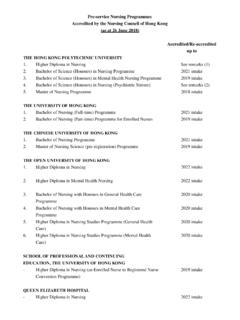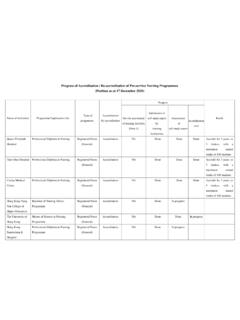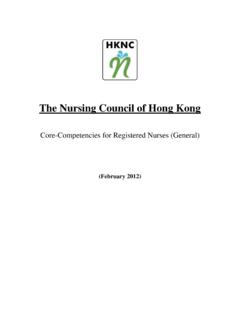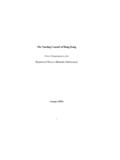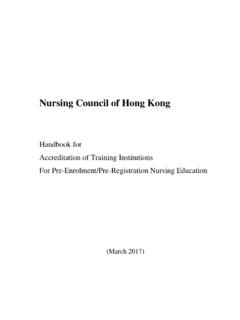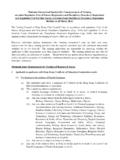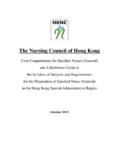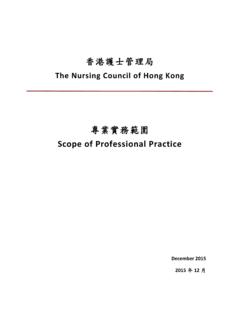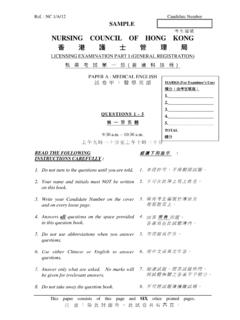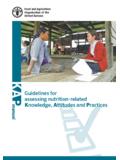Transcription of The Nursing Council of Hong Kong
1 The Nursing Council of hong kong A Reference Guide to the Syllabus of Subjects and Requirements for the Preparation of Registered Nurse (General). in the hong kong Special Administrative Region (June 2016). Content I. Preamble 1. II. Aims and Objectives 1. III. Philosophy of Nursing 2. IV. Theoretical Requirements 4. V. Clinical Practice Requirements 6. VI. Special Considerations 8. VII. Appendices Appendix 1 Essential Topics 10. Appendix 2 Essential Topics in Basic Nursing for Safe Practice 21. Appendix 3 Outline of Topics and Related Contents Under Major Body Systems 31. Appendix 4 Guidelines on Exemption of Requirement on Theoretical Hour for 40. Registered Nurse (General) training I. PREAMBLE. The completion of the transition of Nursing education to tertiary institutes in 2002 has denoted the success of the hong kong SAR in advancing Nursing education to tertiary level in line with international development. To meet the new developments of the health care system and the evolving demands for a more diverse and high quality Nursing service at the primary, secondary and tertiary levels of health care, there is a need to develop a new generation of Registered Nurses (RN).
2 With enhanced professional competencies. Hence, the development of an enriched and expanded Nursing curriculum is essential for the education of RNs. This new syllabus replaces the one published in 2009. It serves as an up-dated guide for curriculum development of pre-registration general Nursing programmes. Upon completion of such programmes and having passed the examinations recognized by the Nursing Council of hong kong (NCHK), students are expected to have acquired the essential competencies for safe, effective and ethical practice, and will be eligible to apply for registration with the NCHK as a Registered Nurse (General) [RN (G)] in hong kong . II. AIMS AND OBJECTIVES. To allow flexibility, creativity and adaptability in curriculum development, the syllabus is written in broad terms. It is intended to achieve the following aims and objectives: AIMS: To serve as : 1. a reference frame for assessing the eligibility of nurses trained outside hong kong Special Administrative Region (HKSAR) for registration as a RN(G).
3 2. a reference base for accrediting general Nursing education programmes. OBJECTIVES: 1. State the Nursing philosophy based on which the syllabus is developed. 2. Highlight the core components of Nursing studies, including the theories and practice of professional Nursing at the three levels of health care and in different health care specialties/settings; Nursing management, research and professional development. 3. Specify the requirements for other related subjects in support of the Nursing studies, such as communication, social and behavioral sciences, biological and integrated sciences as well as legal, ethical and cultural issues. 4. Suggest the number of hours for the different subjects, both in theory and in practice, and provide guidance on the form of assessments required. -1- III. PHILOSOPHY OF Nursing . This stated philosophy of Nursing summarizes our beliefs in the nature and practice of professional Nursing , as well as our views on the person, the environment and health.
4 It provides a basis for the revision of the Nursing syllabus that guides the development of education programmes for RN (G). Nursing is a caring, enabling, knowledge-based and competence-assessed profession which is dynamic in meeting the changing health needs of the society. It is committed to promoting and maintaining health; as well as to caring for the sick and the disabled as individuals, or in families, groups, institutions, home settings and in the community. The practice of Nursing is client-focused and evidence-based. It is carried out at the primary, secondary and tertiary levels of health care. It functions through problem solving and collaboration with the client as well as other health care professionals to define and achieve mutually agreed health goals. The provision of holistic, client-centred care requires research-based professional knowledge and skills through the implementation of the Nursing process; the adoption of a caring and responsible attitude; effective communication and interpersonal skill as well as ethical principles.
5 The quality of care is maintained through the enhancement of professional competencies via continuous Nursing education. The person is a unique, holistic being with the potential to learn and develop through interacting with the changing environment. Each person has intrinsic worth and has the right to participate in the decision-making which affects his/her own life and dignity, and must always be treated with respect. The environment consists of external and internal components which change constantly and generate both positive and negative stressors. The internal environment of a person, comprising biological, psychological, spiritual and intellectual components, interacts with the external environment that encompasses social, cultural and situational influences. This continual interaction affects the person s functioning as an individual, as well as in families, groups and community. The creation, preservation and conservation of a healthy environment is crucial to the maintenance and promotion of health.
6 Health is a state of well-being, perceived differently by the individual at specific points in time along the health-illness continuum. It is affected by biological, psychological, socio-economical, developmental, political, cultural and religious factors. The level of well-being depends on the maintenance of equilibrium within the person, and between the person s interaction with the changing environment. -2- Bibliography th Alligood, M. R. (Ed.). (2010). Nursing theory: (4 ed.). Maryland Heights, Mo.: Mosby Elsevier. American Association of Colleges of Nursing , & Peterson's. (2009). Peterson's Nursing programs 2010 (15th ed.). Lawrenceville, : Peterson's. Berman, A., Snyder, S., Kozier, B., & Erb, G.(2008). Fundamentals of Nursing : Concepts, process, and practice th (8 ed.). New Jersey: Pearson Education. College of Registered Nurses of British Columbia (CRNBC), (2008). Professional standards for registered nurses and nurse practitioners. Retrieved from College of Nurses of Ontario.
7 (2009). Entry to practice competencies for Ontario registered practical nurses. Retrieved from Department of Human Resources for Health, World Health Organization (2009). Global standards for the initial education of professional nurses and midwives. Retrieved from George, (Ed.). (2011). Nursing theories: The base for professional Nursing practice (6th ed.). Boston: Pearson. Hospital Authority. (2002). Core competency sets for Nursing staff (Internal official document). hong kong SAR: Author. Hospital Authority. (2006). Core competency for enrolled nurses, registered nurses & advanced practice nurses in Hospital Authority. Retrieved from (23 Sept06).pdf International Council of Nurses (ICN). (2004). Position statement: Scope of Nursing practice. Retrieved from Nursing & Midwifery Council (NMC). (2004). Standards of proficiency for pre-registration Nursing education. Retrieved from Public Health Nursing Division, Department of Health. (2002). Core-competencies for registered nurse grade (Internal official document).
8 hong kong SAR: Author. The College of Nursing , hong kong . (1993). Standards for Nursing practice. hong kong : Author. The Nursing Council of hong kong (2004). Core-competencies for registered nurses (general). Retrieved from .html World Health Organization. (2002). Strategic directions for strengthening Nursing and midwifery services. Retrieved from -3- IV. THEORETICAL REQUIREMENTS. Overview of Contact Hours1 (Including Laboratory Hours). Competence Area 1: Professional, legal and Ethical Nursing Practice Minimum Item Topics Hours 1A. General, Behavioural and Life Sciences Relevant to Nursing 320. Human Anatomy, Physiology and pathophysiology Sociology of Health Applied Psychology Fundamental Pharmacology Microbiology Nutrition and Dietetics 1B. Professional Nursing Practice 712. The Nursing Profession Basic Nursing for Safe Practice:(Please refer to Appendix 1 for details.). I. The Nursing process II. Essential Nursing techniques in clinical setting for safe practice: 1.
9 Provision of a safe and comfortable environment for care 2. Maintenance and promotion of occupational safety and health 3. Documentation and reporting of care 4. Helping the client meet the basic needs of living 5. Assisting the client to undertake diagnostic procedures 6. Administration of medications 7. Principles of First Aid 8. Infection Control III. Principle and practice of Nursing : 1. Accident and emergency (A&E) Nursing 2. Peri-operative Nursing 3. Introduction to operating theatre techniques, intra-operative care and anaesthetic Nursing 4. Medical and surgical Nursing related to illness prevention and health restoration of clients with alteration in various body system functions across the life span 5. Rehabilitative Nursing 6. Oncology Nursing and palliative care 7. Paediatric and adolescent Nursing 8. Obstetric Nursing 9. Gerontological Nursing 10. Mental health Nursing 11. Community Nursing 12. Chinese medicinal Nursing and complementary and alternative medicine 1.
10 The term contact hours refers to the amount of time (in terms of hours) spent by a learner in direct contact with the teaching/training staff of a programme. It includes attendance in class, tutorials, Nursing laboratory practice, conducting experiment in laboratory under supervision and supervised session in placement and workshop. For other modes of learning, the Nursing Council of hong kong will assess the individual case of merit in the light that there is structured content with learning outcomes, and has interaction and assessment components. -4- Competence Area 1: Professional, legal and Ethical Nursing Practice (Cont'd). Minimum Item Topics Hours 1C. Legal & Ethical Issues 40. Legal Aspects Pertinent to Nursing Practice Ethical Issues 1D. Communication 20. (Included in 1E. Rights and Responsibilities of the Individual and ). 1F. Information Technology in Nursing and Health Care 20. Competence Area 2: Health Promotion and Health Education 2A. Education Theories and Methods 10.
